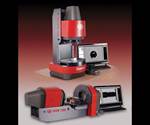Enhanced Point Geometry and Coating Boost Drill Productivity
Seco’s Feedmax P Drill enables shops to drill more holes faster and with more efficient cooling.
Seco Tools, LLC says that with its Feedmax P drill, manufacturers can boost hole-making performance for ISO P steel and cast-iron workpiece materials. The solid carbide Feedmax –P drills can increase drilling productivity as much as 35 percent while also providing longer tool life from the combination of the drill’s new geometry and advanced coating.
The Feedmax P’s new geometry and dark-colored TiAlN coating enhance chip management and deliver high-application security, enabling shops to generate more holes faster and with fewer required drills. In addition to strong straight cutting edges, the drill’s coolant holes are in close proximity to the cutting edges for more efficient cooling, and its narrow land margins minimize the heat exposed to the drill. An enhanced flute design protects drill point corners and maximizes the control and evacuation of chips. Together with the drill’s strong point geometry, cutting speeds of 623 ft/min are possible in SMG P5 without sacrificing tool life.
Seco offers the Feedmax P in diameters ranging from .078" to .787" (2 mm–20 mm) and in length-to-diameter ratios of 3xD, 5xD and 7xD. All drills come standard with through-the-tool coolant channels to ensure maximum performance. Custom versions such as intermediate sizes and chamfer and step drills are available upon request.
Related Content
-
Fundamentals of Designing the Optimal Cooling System
The right mold components can help improve mold cooling and thereby produce higher-quality parts.
-
Machining Center Spindles: What You Need to Know
Why and how to research spindle technology before purchasing a machining center.
-
The Ins and Outs of Hot Runner Temperature Control
A training checklist that explains the why and how of proper hot runner temperature control and system management.












